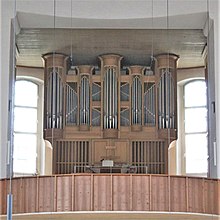Christ the King (Munich)
Christ the King is a Catholic parish church in Munich district Neuhausen-Nymphenburg .
location
The Parish Church of Christ the King is in Nymphenburg at the corner of Prince Street Notburga- few meters from Schlosskanal removed. The postal address of the parish office, which is located directly on Kirchplatz: Notburgastraße 15, 80639 Munich.
history
The old village church of Kemnaten, as Nymphenburg was originally called, had to give way to the extensions to the Nymphenburg Palace that had been started by Elector Max Emanuel in 1701 . The people living in and near the castle were initially looked after by Capuchins , in the 19th century by court curates . The castle chapel also served as a place of worship for the local population. Only when the city of Munich expanded at the turn of the 20th century and the population of Nymphenburg grew rapidly, a church building association was founded to build a new parish church. After delays caused by war and inflation, the parish of St. Magdalena was established in 1922 and the church was finally built between 1928 and 1930. As planned for a long time, the name of the parish was changed to Christ the King in 1936 .
On February 25, 1945, the church was destroyed by a bomb attack. From 1947 to 1950 it was rebuilt under the direction of Sep Ruf . In 1977 the building was renovated. 42
Pastor of Christ the King
- Wilhelm Lurz (1992-1990) pastor in Christ the King from 1942
- Josef Maß (1936-2006) Pastor in Christkönig (1973-2006)
architecture
The church was built according to the design of the Munich city planning officer August Blößner . He was inspired by Dominikus Zimmermann's pilgrimage church in Steinhausen with the oval floor plan , but built a simple, classic-looking nave on it, which is divided by ten cones that refract and reflect the light entering through high windows in a variety of ways. The oval is lengthened by an attached chancel, which is illuminated by four more windows. Originally 14 steps led up to the sanctuary. The nave had a flat coffered ceiling. The church is set off from the street by a forecourt. You enter it via a portico with twelve columns and a transverse oval as an entrance hall under the music gallery. The two 37 m high towers are attached to the outer wall of the oval and are therefore at an angle of 30 ° to the center line.
Sep Ruf largely stuck to the original design when rebuilding the church. However, he lowered the sanctuary, which is now only accessible via seven steps. For the ceilings of the nave and the chancel, he chose flat domes structured by wooden trusses, which are suspended from the roof structure. He raised the outer facade above the entrance by one story and divided the towers with only two instead of four cornices, which gave them a taller and slimmer appearance.
In the northern tower is the bells of the parish church, which is tuned as a Salve-Regina motif in the tone sequence H ° - dis '- f sharp' - g sharp '- h' in bronze bells from the Karl Czudnochowsky / Erding foundry.
The church and the rectory at the back are under monument protection.
Furnishing
The main altar made of shell limestone was created in 1977 by Blasius Gerg . The Assumption of Mary by Giovanni Lanfranco hangs in the chancel , on loan from the Bavarian State Painting Collections . The picture painted in 1631 was originally in the Dominican Church in Augsburg .
The Tabernacle of Alois Wörle (1930) has survived as a single piece of the bomb attack. The large cross above the tabernacle (around 1899) comes from the orphanage church in neighboring Neuhausen, which was also destroyed . The Marien Altar on the left consists of a Madonna and Child from the early 18th century and accompanying angels (Lower Austria, 18th century). The Sacred Heart Altar on the right was created in 1944 by Peter Glitzinger, the 14 bronze tablets of the Stations of the Cross were created in 1950/51 by Hans Wimmer .
organ
The organ has 44 registers , divided into three manuals and pedal , with a total of 3308 pipes . It was built in 1984 by WRK-Orgelbau Munich and consecrated on March 17, 1985. Restoration by the Munich organ builder Johannes Führer followed in 2005 . She has the following disposition :
|
|
|
|
|||||||||||||||||||||||||||||||||||||||||||||||||||||||||||||||||||||||||||||||||||||||||||||||||||||||||||||||||||||||||||||||||||||||||||||||||||
- Coupling : II / I, III / I, III / II, I / P, II / P, III / P
- Playing aids : 32-fold electronic typesetting system
Web links
Individual evidence
- ↑ Official website of the parish Christkönig Munich-Nymphenburg
- ↑ Illustration on the engraving by Michael Wenig to the right of the castle
- ↑ The information in this article is largely based on: Josef Maß : Christkönig Munich-Nymphenburg (= Schnell, Art Guide No. 1987). 2nd Edition. Schnell & Steiner, Regensburg 2003, ISBN 3-7954-5709-2 .
- ^ Wilhelm Lurz, in: Critical online edition of the diaries of Michael Cardinal von Faulhaber (1911-1952). Available at: https://www.faulhaber-edition.de/kurzbiografie.html?idno=05573. Last accessed June 24, 2020.
- ↑ DenkmalViewer , Az. D-1-62-000-4807
- ^ Website of the State Painting Collections (accessed July 7, 2019).
- ^ Organ Databank (Dutch), accessed September 4, 2019.
Coordinates: 48 ° 9 ′ 25 " N , 11 ° 30 ′ 43.7" E




